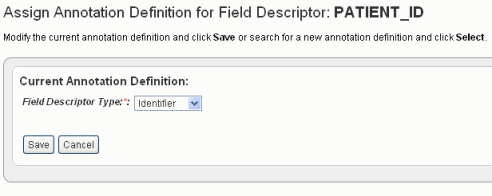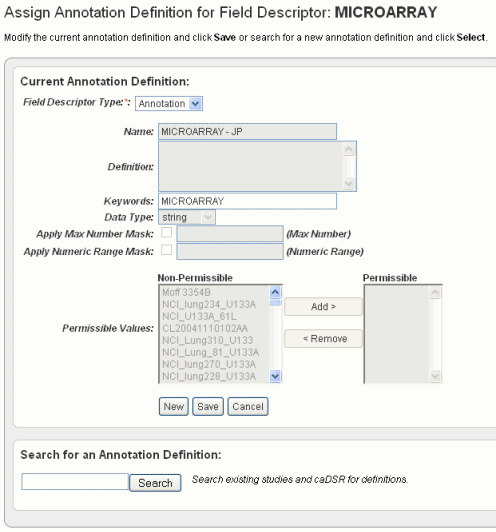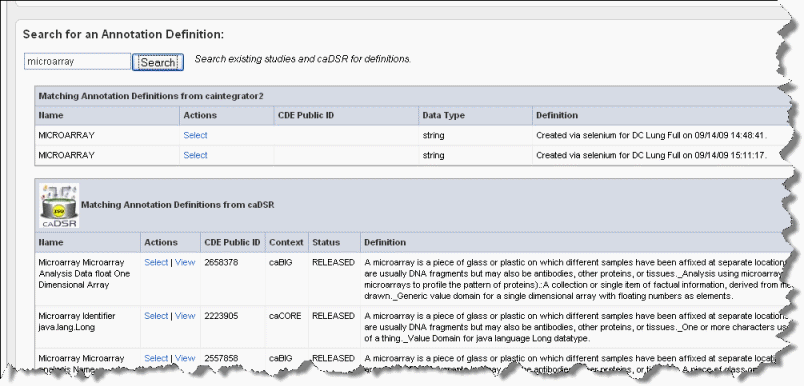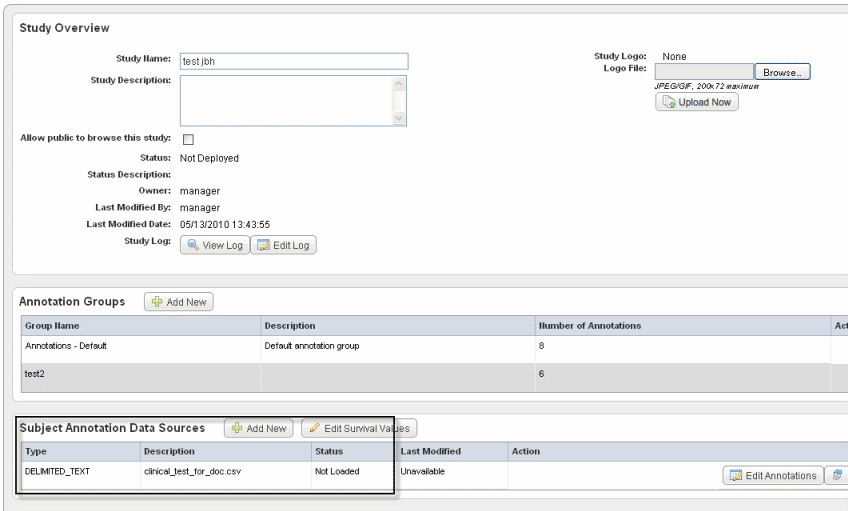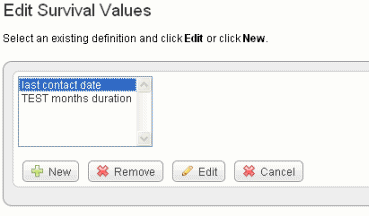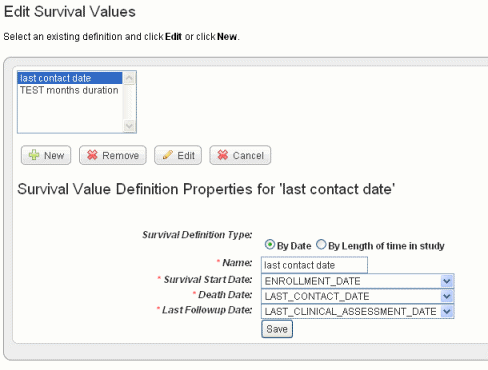 |
Page History
...
- Enter or change (if editing) the name and/or description.
- Select or verify the checkbox to specify if you want to allow public access to the study.
- For the study log feature, click View Log or Edit Log. See #Study Log for details about the log.
- Click Save.
Info title Note You can save the study at any point in the process of creating it. You can resume the definition and deployment process later.
- If you choose to add a logo for the study, click the Browse button corresponding to Logo File in the upper right of the Edit Study page. Navigate for the file, and click Browse. The file name type displays above the Upload Now button.
- Click the button to upload the logo. Once you save the study (or its edit), the logo displays in the center of the page. On the home page for the study, the logo displays in the upper left, above the sidebar.
...
One of the most important factors in creating a study in caIntegrator is in properly annotating the data. Each annotation has a definition you must identify. Because the process can be quite complex, you might want to review the following steps for working with annotations.
Annotation workflow summaryWorkflow Summary:
- Add an annotation group. This optional step is for users who have a rigid data dictionary of all annotations relevant to the study. This step can also be helpful in cases where a study has many annotations. For more information, see #Adding an Annotation Group.
- Add subject annotation data. This consists of multiple sub-steps.
- Add a new subject annotation data sources file. This step uploads the file and starts the workflow for assigning uploaded data definitions. See #Editing an Annotation Group , step 1.
- Edit the annotations. This step opens the Define Fields for Subject Data page. See #Editing an Annotation Group, step 2.
- In the Define Fields for Subject Data page, review possible definitions in the annotation group associated with this study. See #Define Fields Page.
- Assign the visibility of each annotation definition. See #Editing an Annotation Group, step 2.
- Locate and verify the assignment as "identifier" for one annotation. See #Assigning an Identifier or Annotation.
- Review, verify and assign definitions for each annotation. You can do this in one of four ways:
--Accept existing default definitions as described in the associated annotation group. See #Assigning an Identifier or Annotation.
--Create or manage definitions manually. See #Assigning an Identifier or Annotation.
--Search for and use definitions existing in other caIntegrator studies. see See #Searching for Annotation Definitions.
--Search for and use definitions from caDSR. see See #Searching for Annotation Definitions.
- Load the Subject Annotation Source. Up until this point, you can periodically save your work with the annotations, but before you can deploy the study, you must complete this step.
- Deploy the study. See #Deploying the Study.
Adding An Annotation Group
This topic opens from both the Create Annotation Group page and the Edit Annotation Group page. If you plan to create a group, continue with this topic. If you plan to edit an annotation group, see #Editing an Annotation Group.
annotation group:adding;adding:annotation groupAn An annotation group is a group of annotation definitions configured in a CSV file. This feature is primarily meant for the Study Manager who knows that they have tightly restricted vocabulary definitions that are relevant to a study. In this optional step, you can review the uploaded Group Definition Source file before assigning the appropriate definition definitions for your study.
To add an annotation group, follow these steps:
...
| Info | ||
|---|---|---|
| ||
Annotation definitions by default are visible only to the Study Manager's group. They are not visible to all caIntegrator users, unless you change the visibility for each. See Editing an Annotation GroupThis topic opens from the Edit Annotation Group page. You may want to refer to #Adding an Annotation Group if you are adding a group for the first time. |
...
To edit an annotation group, on the Edit Study page for a study with an existing annotation group, click the Edit Group button.
Adding Subject Annotation DataThe Edit Study page, described in #Creating/Editing a Study, opens after you save a new study or click to edit an existing study. To add subject annotation metadata on this page, follow these steps:
After the data file is uploaded to this study, it will be listed in the Subject Annotation Data Sources section of the Edit Study page. From this page you can initiate editing the annotations. In the Subject Annotation Data Sources section, click Edit Annotations corresponding to the subject annotations that have been uploaded for the study. This open the #Define Fields Page for Editing Annotations. Define Fields Page for Editing AnnotationsThe Define Fields for Subject Data page, shown in the following figure, opens when you click Edit Annotations in the Subject Annotation Data Sources or the Image Data Sources section of the Edit Study page. The exception to this is if you have not yet imported annotations for the imaging data for the study, In that case, when you click the Edit Annotations button in the Imaging Data Sources section, a page opens where you can identify and upload image annotation data. See #Adding or Editing Image Annotations. If this Define Fields page opens after clicking the Edit Annotations button, working with this page is identical for both subject and image annotations The first column of the table on this page displays annotation groups that have been created for this study. For more information, see #Adding an Annotation Group.
|
...
3 To indicate the unique identifier of choice, on the row showing the column header (PatientID in the figure, but other examples are subject identifier, sample identifier, etc), click Change Assignment in the |
...
Annotation Definition column. Assigning An Identifier or Annotation |
...
When you click Change Assignment on the |
...
...
page, the Assign Annotation Definition for Field Descriptor dialog box opens |
...
. On this page you can change the column type and the field definition for the specific data field you selected.
When you change an assignment, you must make sure the data types match--numeric, etc. |
...
- For the column (PatientID) that you choose to be the one and only Identifier column (in this case, PatientID), in the Column Type drop-down list, select Identifier. The following figure shows the dialog box rendering when "identifier" is selected in the Field Descriptor Type drop-down list.
- Click Save to save the identifier. This returns you to the Define Fields for Subject Data page where the Identifier is noted in the Field Annotation Definition column.
- After you have defined which field is the Identifier, you must ensure that ALL other data fields also have a field an annotation definition assignment. For those fields without a Field Definition an annotation definition assignment or for those whose Annotation Definition annotation definition you want to review, click Change Assignment.
- In the Assign Annotation Definition for Field Descriptor dialog box, shown in the following figure, select Annotation in the drop-down list.
As you select the column type, you can work with column headers in one of four ways in this dialog box.
- You can accept existing default definitions (those that are inherent in the data file you selected). See Step 5.
- You can create and/or manage your own definitions manually. See Step 6.
- You can search for and use definitions in other caIntegrator studies. See #Searching for Annotation Definitions.
- You can search for and use definitions found in caDSR. See #Searching for Annotation Definitions.
5. Review the current annotation definition in the Assign Definition page, Current Annotation Definition section. Click Cancel to return to the Define Fields... page.
You can still initiate a search for another annotation definition in the Search for an Annotation Definition section on the browser page if you choose to change the definition. See the following figure. See also #Searching for Annotation Definitions. Click Save to retain any changes.
...
- 6. To enter a new name annotation, or any other information about the annotation definition, click the New button and enter the information described in the following table.
Annotation Field
Field Description
Name
Enter the name for the annotation.
Definition
Enter the term(s) that define the annotation.
Keywords
Insert keyword(s) that
could be used to find the annotation in a search, separated by commas.
Data Type
Select a string (default), numeric, or date.
Apply Max Number Mask
This field is available only for numeric-type annotations, or when a new definition is created. This feature is unavailable when permissible values are present.
Select the box and enter a maximum number for the mask, such as "80" for age. When you query results above the value of the mask, then the system displays the mask and not the actual age.
Note: If you enter masks of both "max number" and "range", caIntegrator applies both masks at the same time.
The
#Data Dictionary page now has a Restrictions column that shows restrictions whenever a mask has been applied.
Apply Numeric Range Mask
This field is available only for numeric-type annotations, or when a new definition is created. This feature is unavailable when permissible values are present.
Select the box and enter a width of range for the mask, such as "5" representing blocks of 5 years. For example, if you enter a width of 5, the query only allows age blocks of 0-5, 6-10, 11-15, etc.
When you query results above the value of the mask, then the system displays the mask and not the actual age ranges.
Note: If you enter masks of both "max number" and "range", caIntegrator applies both masks at the same time.
The Data Dictionary page now has a Restrictions column that shows restrictions whenever a mask has been applied.Permissible/Non-permissible Values
Note: The first time you load a file, before you assign annotation definitions, step #3 in #Assigning An Identifier or Annotation, these panels may be blank. If the column header for the data is already "recognizable" by caIntegrator, the system makes a "guess" about the data type and assigns the values to the data type in the newly uploaded file. They will display in the Non-permissible values sections initially. Use the Add and Remove buttons to move the values shown from one list to the other, as appropriate.
- 6. To enter a new name annotation, or any other information about the annotation definition, click the New button and enter the information described in the following table.
When you select or change annotation definitions by selecting matching definitions (described in #Searching for Annotation Definitions), this may add (or change) the list of non-permissible values in this section.
If you leave all values for a field in the Non-permissible panel, then when you do a study search, you can enter free text in the query criteria for this field.
If there are items in the Permissible values list, then the values for this annotation are restricted to only those values. When you perform a study search, you will select from a list of these values when querying this field. If there are no items in the permissible values list then the field is considered free to contain any value.
To edit a field's permissible values, you must change the annotation definition. You can do this even after a study has been deployed.
Note: You cannot edit permissible values in an existing annotation definition. To change permissible values, you must create a new annotation.|
Searching for Annotation Definitions
...
- Enter search keyword(s) in the Search text box on the Assign Annotation Definition page (the preceding figure). Click Search or click Enter to launch the search. After a few moments, the search results display on the page shown in the following figure.
Wiki Markup To view the definitions corresponding to any of the "Matching Annotation Definitions", which are those currently found in other caIntegrator studies, click the \[term\], such as "age", hypertext link. The definition then appears in the Current Annotation Definition segment of the page just above.
...
You can modify any portion of the definition, as described in ste #6 in #Assigning an Identifier or Annotation.
- The matches from caDSR display some of the details of the search results. To view more details of a match, such as permissible values, click View, which opens caDSR to the term. If you click Select, the caDSR definition automatically replaces the annotation definition for this field with which you are working.
Note title Caution Take care before you add a caDSR definition that it says exactly what you want. caDSR definitions can have minor nuances that require specific and limited applications of their use.
- Once you have settled on an appropriate field definition for the annotation, click Save. This returns you to the Define Fields for Subject Data page.
Info title Note If you have not clicked Select for alternate definitions in this dialog box, then click Save to return to the Define Field...dialog box without making any definition changes.
- From the Define Fields for Subject Data page, be sure and designate the data types for each field in the file. Click Save on each page to save your entries or click New to clear the fields and start again. You will not be able to proceed until every field definition entry on the Fields for Subject Data screen has an entry, one as the unique Identifier and the remainder as annotations.
...
| Tip | ||
|---|---|---|
| ||
Saving your entries in this way saves the study by name and description, but does not deploy the study. See #Deploying the Study. |
The Edit Study page now displays a "Not Loaded" status for the file whose annotations (column headers) you have defined. An example of a file whose annotations have been defined but not yet loaded is shown in the following figure.
...
- Definition Incomplete – An annotation definition or definitions must be modified on the Define Fields for Subject Data page. This status may be displayed because an identifier has not been selected. See #Define Fields Page for Editing Annotations.
- Not Loaded – The annotation definitions must be loaded before a study can be deployed. If an error appears after attempting to load a subject annotation source, cick the Edit Annotations button which takes you to the Define Fields for Subject Data page where the problematic annotations will appear in red. See #Define Fields Page for Editing Annotations.
- Loaded – The annotation definitions are properly loaded.
- Click the Load Subject Annotation Source button in the Action section to load the data file you have configured, The Deploy Study button, to this point has been unavailable, but this step activates the button.
Info title Note You can add as many files as are necessary for a study. Patients 1-20 in first file, 21-40 in second file, or many patients in first file and annotations in second file, etc. As long as IDs are defined correctly, it works.
- Click Deploy Study. caIntegrator now loads data from the file to the caIntegrator database, and the file status changes to "Loaded".
Info title Note You can change assignments even after the study is deployed, using the Edit feature. For more information,
...
The Manage Studies page opens when the study is deployed. The Deployed status is indicated on the Manage Studies page as well as the Edit Study page. For more information, see #Managing a Study.
You can continue to perform other tasks in caIntegrator while deployment is in process.
See also #Deploying the Study.
| Info | ||
|---|---|---|
| ||
You can repeatedly upload additional or updated subject annotations, samples, image data, array data to the study at later intervals. These later imports do not remove any existing data; they instead insert any new subjects or update annotations for existing subjects. |
Defining Survival Values
survival values, defining;defining survival valuesSurvival Survival value is the length of time a patient lived. If you plan to analyze your caIntegrator data to create a Kaplan-Meier (K-M) Plot, then during the Annotation Definition process described above in #Assigning an Identifier or Annotation, you should do one of two things:
- Make sure that you have defined at least three fields set to the "date" Data Type. These will be matched to the following three properties during Survival Value definition.
- Survival Start Date
- Death Date
- Last Followup Date
Info title Note Setting survival values is optional if you do not plan to use the K-M plot analysis feature or if you do not have this kind of data (survival values) in the file.
- It is also possible to generate KM plots if an Annotation Field Descriptor such as DAYSTODEATH has been set to Data Type 'numeric'. See #Assigning an Identifier or Annotation.
For some applications, such as REMBRANDT and I-SPY, survival values are pre-defined in the databases when you load the data. In caIntegrator, however, you can review and define survival value ranges in a data set you are uploading to a study. To be able to do so, you need to understand the kind of data that can comprise the survival values.
To set up survival values, follow these steps:
- On the Edit Study page, click Edit Survival Values. This opens the Survival Value Definitions dialog box, shown in the following figure.
- Click New to enter new survival value definitions.
- OR -
Click Edit to edit existing survival value definitions.
The dialog box extends, now displaying radio buttons and three drop-down lists that show column headers for date metadata in the spreadsheet you have uploaded.
...
- If survival value ranges
...
- have already been added to a study, they display on the page. the dialog box is shown in the following figure.
- Survival values can be defined by Date or by Length of time in the study. Select the radio button for the category that defines your survival data.
- In the drop-down lists, select the appropriate survival value definitions for each field listed. You might want to refer to the column headers in the data file itself. Dates covered by the definitions are already in the data set. You cannot enter specific dates.
Field Type
Description
Survival Definition Type
...
Select whether the survival time is defined by dates or length of time subject was in the study.
Name
...
Enter a unique name that adequately describes the survival values you are defining here. Example: Survival from Enrollment Date or Survival from Treatment Start. The name you enter displays later when you are selecting survivals to create the K-M plot.
Survival Length Units
...
Select the appropriate units for this data.
- Survival Start Date
...
Select the column header for this data.
- Death Date
...
Select the column header for this data.
- Last Followup Date
...
Select the column header for this data.
See also on page 82.
Updated the Edit Survival Value Definitions page, now has a radio button and 2 different types of ways to define survival valuesFor data analysis using survival values, see Creating Kaplan-Meier Plots.
Adding/Editing Genomic Data
...

